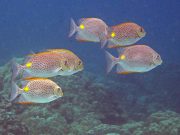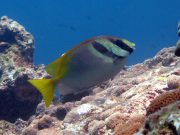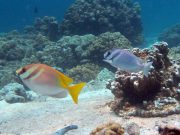Diving with Rabbitfish
Lanta Marine Life | Siganidae
Rabbitfish are a colourful and easily identified family of 29 species, of which several species are found on Koh Lanta diving trips. The name rabbitfish is derived from their peaceful temperament, rounded blunt snout, and rabbit-like appearance of the jaws.
These fish have large eyes and can grow to around 50 cm, though most are observed around 25 - 35 cm. Most species have either bright colors or a complex pattern. The spines of rabbitfish are particularly sharp and some species carry a toxin.
All species feed on algae and plankton, however some others also feed on jellyfish and other animals if the opportunity arises. Some species are observed in schools, with others in smaller groups or singly among corals.
6 species found on this page:
Coral Rabbitfish
(Siganus corallinus)

Siganus corallinus @ Koh Haa
The coral rabbitfish has a yellow body, covered with numerous close-set blue spots. The fins are yellow. There is a dark area around the eye and under the chin, which is a remnant of a dark chin to eye band which is present in juveniles.
The coral rabbitfish grows to 25 cm but is usually observed in the 15 cm - 20 cm range. Like other rabbitfish, this species has stout, venomous spins which cause a painful, but not fatal, defensive sting to humans. Feed on algae and often seen in pairs.
According to Reef Fish Identification (Tropical Pacific), 2003, by Allen, G., Steene, R., Humann, P., DeLoach, N., the coral rabbitfish does not have a dark area under the chin. Reef Fish Identification (Tropical Pacific) assigns the dark chin area to be a unique identifying feature of the blackeye rabbitfish (Siganus puelloides) which it describes as a pale blue fish with yellow spots.
Golden Rabbitfish
(Siganus guttatus)

Siganus guttatus @ Koh Haa
The golden rabbitfish is generally a pale greyish blue bodied fish, with numerous reddish/orange golden spots on the head, body and tail fin.
The lower body is more silvery. The dorsal and anal fins have yellowish orange margins. There is a large yellow spot at the end of the dorsal fin, just before the tail base.
The golden rabbitfish grows to 35 cm and is often seen in small groups, hanging almost motionless over shallow reef areas. May form larger groups in deeper water. This species has stout, venomous spines and may cause a painful (but not fatal) defensive sting.
Java Rabbitfish
(Siganus javus)

Siganus javus @ Koh Haa
The Java, or streaked rabbitfish is common to all dive sites around Koh Lanta. The body is page greyish, with many bluish white spots on the head and upper part of the body. The central and lower parts of the body have wavy lines and streaks. The head is yellowish, as are the dorsal and anal fins. The tail fin is usually darkish.
The Java rabbitfish grows to 53 cm, but usually observed in the 25 cm to 35 cm range. The dorsal fin spines are stout and sharp, and can cause a painful defensive sting.
These fish normally feed on algae, but are also opportunistic feeders and will feed frantically on passing jellyfish. It is unusual to see this species alone, they usually form loose, small groups in shallow water, and sometimes very large groups in deeper water. Enjoys congregating under boats.
Virgate Rabbitfish
(Siganus virgatus)

Siganus virgatus @ Koh Haa
The virgate rabbitfish is common to many dive sites around Koh Lanta. The upper body colour ranges from pale blue to yellow, with the lower body usually pale bluish to whitish. There are a pair of diagonal dark bands, one on the head, and one at the front of the body. Each diagonal dark band is followed by a lighter band. Most of the body is covered with faint bluish spots.

Virgate Rabbitfish with Blue Variation @ Koh Haa
The virgate rabbitfish has strong, venomous spines, and grows to 30 cm, but more commonly observed around 20 cm. Juveniles will form small groups, and adults will generally form pairs. The diet includes phytoplankton, zooplankton, algae, and small invertebrates.
Vermiculate Rabbitfish
(Siganus vermiculatus)

Siganus vermiculatus @ Koh Haa
The Vermiculate Rabbitfish has a bluish white body with a maze of wavy yellowish brown bands.
There are small dark spots on the tail fin base and tail fin, which has a vertically straight margin.
The head may be yellowish. The rear dorsal and anal fins have dark diagonal stripes.
The Vermiculate Rabbitfish grows to 37 cm and usually forms groups.
Dusky Rabbitfish
(Siganus fuscescens)

Siganus fuscescens @ Koh Haa
The Dusky Rabbitfish has a greyish to bluish grey body, often with an olive-green upper body. This species has numerous small blueish to golden spots on the body.
The Dusky Rabbitfish grows to 30 cm, but is always seen much smaller than this, more often in the 10 cm - 15 cm range.
This is a common species at the dive sites around Koh Lanta, and small schools can often be seen grazing on algae over rocks and dead corals, or over sandy areas close to the reef.
Diving with Rabbitfish around Koh Lanta
Scuba Diving & Snorkel Trips
If you'd love a chance to spot Rabbitfish on one of our daily high season diving trips from Koh Lanta then send us an email to info@diveandrelax.com.
Join our high season speedboat dive trips to some of Thailand's best dive sites and enjoy small groups, short journey times, with a focus on great personal service, safety and fun.
Not yet a certified diver? Learn to Scuba Dive on Koh Lanta with the 3 day SSI Open Water Diver course.
Book online to save 10% on dive trips and scuba courses on Koh Lanta.
Find Out More
Indo-Pacific Marine Life Guides
- Allen, G., Steene, R., Humann, P., DeLoach, N. (2003) Reef Fish Identification, Tropical Pacific. Jacksonville, FL., USA: New World Publications, Inc., ISBN 1-878348-36-1.
- Humann, P., DeLoach, N., (2010) Reef Creature Identification, Tropical Pacific. Jacksonville, FL., USA: New World Publications Inc., ISBN 978-1-878348-44-9
- Debelius, H. (2013) Indian Ocean Reef Guide. Frankfurt, Germany: IKAN - Unterwasserarchiv, ISBN 978-3-939767-52-7.
- Debelius, H. (2004) Nudibranchs and Sea Snails, Indo-Pacific Field Guide. Frankfurt, Germany: IKAN - Unterwasserarchiv, ISBN 3-925919-51-1
- Erhardt, H., Knop, D. (2015) Corals Indo-Pacific Field Guide. Frankfurt, Germany: IKAN - Unterwasserarchiv, ISBN 3-925919-69-4.
- Veron J.E.N., Stafford-Smith M.G., Turak E. and DeVantier L.M. (2016). Corals of the World
